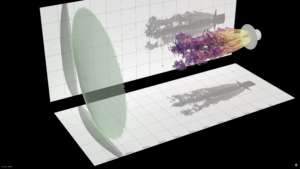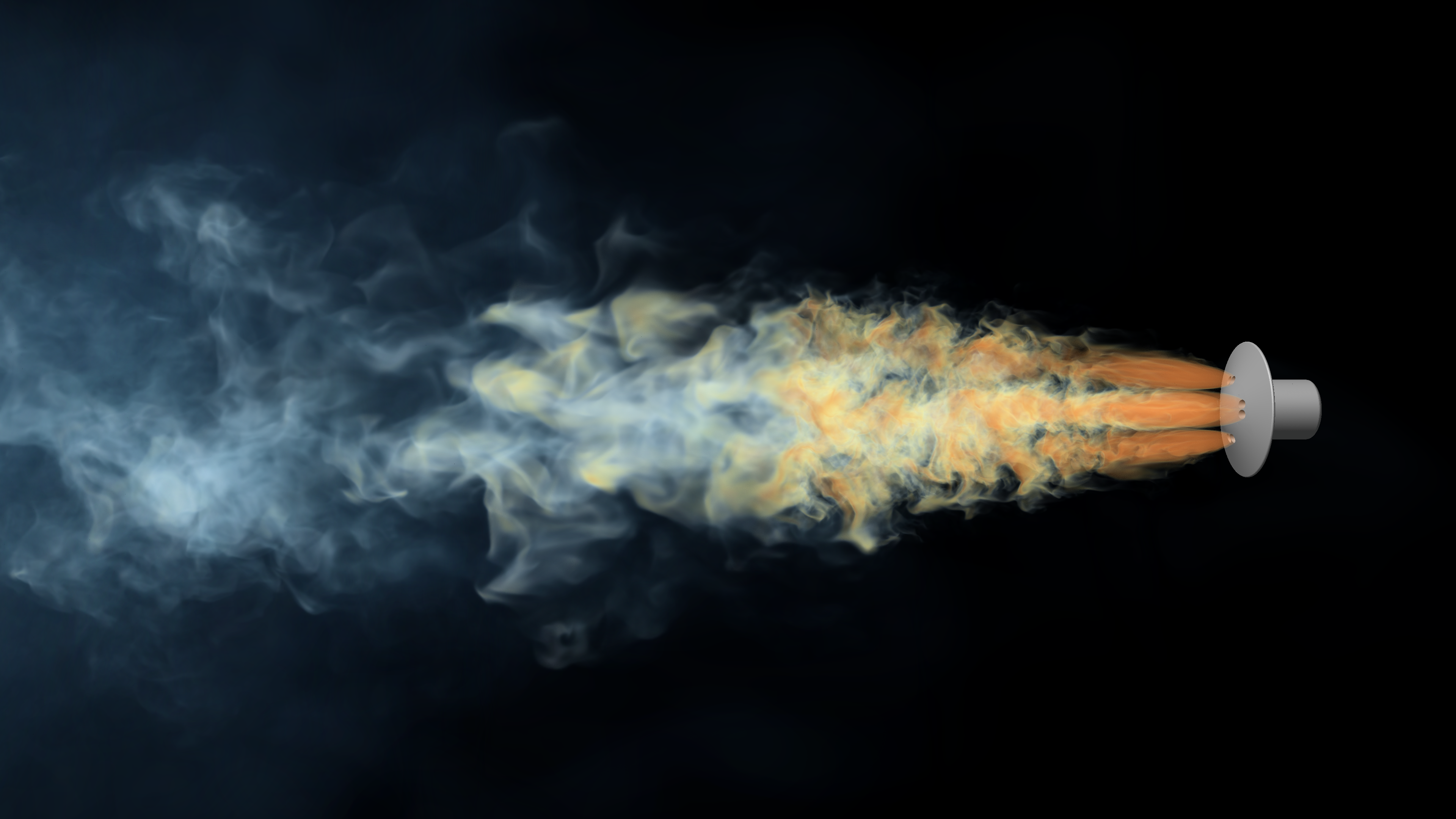NASA aims to land humans on Mars by 2040, overcoming enormous engineering obstacles – in particular, designing a vehicle that can land on the red planet safely.
Mars is surrounded by mostly carbon dioxide, an atmosphere about a hundredth as dense as Earth’s nitrogen- and oxygen-rich air. As such, spacecraft would fly much differently on Mars than on Earth, and there’s no way to fully test here how a lander would perform there.
To carry people and cargo to the surface of Mars, a lander will be the size of a two-story house or bigger, so researchers working on lander designs need the scale that only emerging high-performance computing systems can offer. “As our problems get even bigger and more challenging, we’re becoming increasingly reliant on computations,” says Eric Nielsen, part of a NASA-led team applying supercomputing to the task.

Static snapshot of Mars lander at Mach 1.4 flight condition. Direction of travel is from right to left. The plumes represent isosurfaces of the mass fraction of water colored with vorticity magnitude. Grid lines indicate 10-meter spacing intervals with the bow shock shown as a transparent green surface about 100 meters upstream of the vehicle. Image courtesy of Patrick Moran/NASA Ames Research Center.
Nielsen has been interested in space from childhood, growing up near NASA Langley Research Center in Hampton, Virginia. For the past two decades, he, colleague Ashley Korzun and others have advanced simulation capability to understand how Mars spacecraft would handle entry, descent and landing – known collectively as EDL. The team includes aerospace engineers, computer scientists, mathematicians and scientific visualization experts from Langley and NASA’s Ames Research Center, plus chipmaker NVIDIA, the National Institute of Aerospace, and partners at Old Dominion University and Georgia Tech.
EDL is a mission’s shortest and most intense phase, bringing spacecraft down from more than 12,000 miles an hour to a safe and soft landing in about seven minutes. Most successful Mars probes, including the Perseverance rover that landed in February 2021, based their EDL approaches on improvements to technologies initially developed for the 1970s’ Viking Mars landers. With NASA eager to land people and big spacecraft on Mars, the team has realized that incremental improvements to old methods won’t do.
Using Summit, the flagship supercomputer at the Department of Energy’s Oak Ridge Leadership Computing Facility, Nielsen and his team have modeled EDL for spacecraft large enough to carry Mars explorers. So far, Nielsen says, they’ve logged the equivalent of billions of CPU core-hours in just a few years.
Most of the simulations focus on spacecraft descent, says Korzun, the team’s science lead. The project aims to understand what physics are most important for models to capture, how these future vehicles will fly and how to steer and control them in a way that’s trustworthy enough to carry humans. The team’s simulations explore the environments and forces the vehicle will encounter.
‘The atmosphere on Mars really changes the way these rocket exhaust plumes behave.’
For example, larger spacecraft require big rocket engines to land, but the drag surfaces that slow a ship distort exhaust plumes and affect vehicle behavior. The spacecraft will fly through a mess of rocket exhaust that is unlike the clean, uniform atmosphere an Earth airliner cruises through at 35,000 feet. “The presence of the atmosphere on Mars really changes the way these rocket exhaust plumes behave,” Korzun says.
The researchers were surprised when the simulations showed that the chemistry outside the engines matters more than previously believed. Besides measuring the effects of carbon dioxide, nitrogen, water vapor and other atmospheric components, the team found that hydroxyl radicals – molecules consisting of single oxygen and hydrogen atoms – were presented in larger than expected amounts. The gas, originally believed to be a minor chemical species in the Martian atmosphere, appeared to alter the chemical composition of the gas the vehicle flies through, changing pressure on its aerodynamic surfaces and thus the forces it experienced.
The team has partially validated the Summit simulations with less complex data gathered from wind-tunnel tests on water-bottle-sized models, Korzun says. But there is no dataset that’s directly comparable with the simulations – and the hypothetical model spacecraft can’t be tested on Earth.
Summit has given the team unprecedented capability. Before gaining access to it and other supercomputers that employ GPUs (graphics processing units) to accelerate calculations, the researchers tapped machines that yoked thousands of CPUs (conventional central processing units) for their simulations. That became untenable and computationally costly as the researchers added more detail in each iteration.
Aaron Walden and Gabriel Nastac of NASA Langley have been leading the migration effort, Nielson says.
Migrating from CPUs to GPUs was a huge challenge, he notes, forcing the team “to basically go back to the drawing board and learn how to port our codes to an entirely different class of architectures.”
But it’s been worth it, Nielsen says. “If we want to continue to gain new understanding, the system and technologies have to (fundamentally) change. Incremental improvements were not going to get us there; we were looking to completely change how we do things.”
